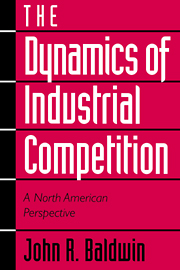Book contents
- Frontmatter
- Contents
- preface
- Acknowledgements
- 1 The dynamics of competition
- 2 Greenfield entry and closedown exit
- 3 Entry, exit, and the merger process
- 4 The rise and fall of incumbents
- 5 Patterns of large- and small-firm mobility
- 6 Plant turnover in Canada and the United States
- 7 Measures of market structure and the intensity of competition
- 8 The relationship between mobility and concentration
- 9 Turnover and productivity growth
- 10 Merger success
- 11 Turnover in domestic and foreign enterprises
- 12 Industry efficiency and firm turnover in the Canadian manufacturing sector
- 13 Firm turnover and profitability
- 14 Modelling entry
- 15 Conclusion
- Appendix A Measuring firm turnover – methodology
- Appendix B Definition of concentration and mobility measures
- Notes
- References
- Author index
- Subject index
7 - Measures of market structure and the intensity of competition
Published online by Cambridge University Press: 30 March 2010
- Frontmatter
- Contents
- preface
- Acknowledgements
- 1 The dynamics of competition
- 2 Greenfield entry and closedown exit
- 3 Entry, exit, and the merger process
- 4 The rise and fall of incumbents
- 5 Patterns of large- and small-firm mobility
- 6 Plant turnover in Canada and the United States
- 7 Measures of market structure and the intensity of competition
- 8 The relationship between mobility and concentration
- 9 Turnover and productivity growth
- 10 Merger success
- 11 Turnover in domestic and foreign enterprises
- 12 Industry efficiency and firm turnover in the Canadian manufacturing sector
- 13 Firm turnover and profitability
- 14 Modelling entry
- 15 Conclusion
- Appendix A Measuring firm turnover – methodology
- Appendix B Definition of concentration and mobility measures
- Notes
- References
- Author index
- Subject index
Summary
Let us remember that measures of concentration, whether they try to measure the concentration of ownership, profits, or market policies within an industry, are only one among many possible indexes of oligopoly power.
Tibor Scitovsky (1955: 101–2)Introduction
Mobility statistics directly measure the extent to which firms replace one another during the course of the competitive struggle. Measures of market structure have tended to focus on inequalities in firm size during the course of the struggle. The two measures therefore address quite different questions about the competitive process. This chapter asks how they are related. In doing so, it provides evidence that the two measures need to be used in conjunction with each other rather than separately because the information they produce is complementary. This chapter asks whether the dimensions of intra-industry mobility are captured by concentration statistics. Chapter 8 reverses the question and asks whether mobility statistics explain concentration levels.
Concentration statistics: the conventional wisdom
In the field of industrial organization, market structure is seen as having considerable stability. This is based on two inter-related but mutually reinforcing factors, one empirical, the other theoretical.
The measure of market structure that is most widely used in the United States, the United Kingdom, and Canada is a measure of concentration. The most commonly used concentration measure is the percentage of output (or any other indicator of industry size, such as employment or assets) accounted for by a small number of the largest firms – typically four in North America. Measures of concentration capture characteristics of the firm-size distribution at a point in time. The size distribution changes slowly over time and so do the associated measures of concentration.
- Type
- Chapter
- Information
- The Dynamics of Industrial CompetitionA North American Perspective, pp. 153 - 175Publisher: Cambridge University PressPrint publication year: 1995



